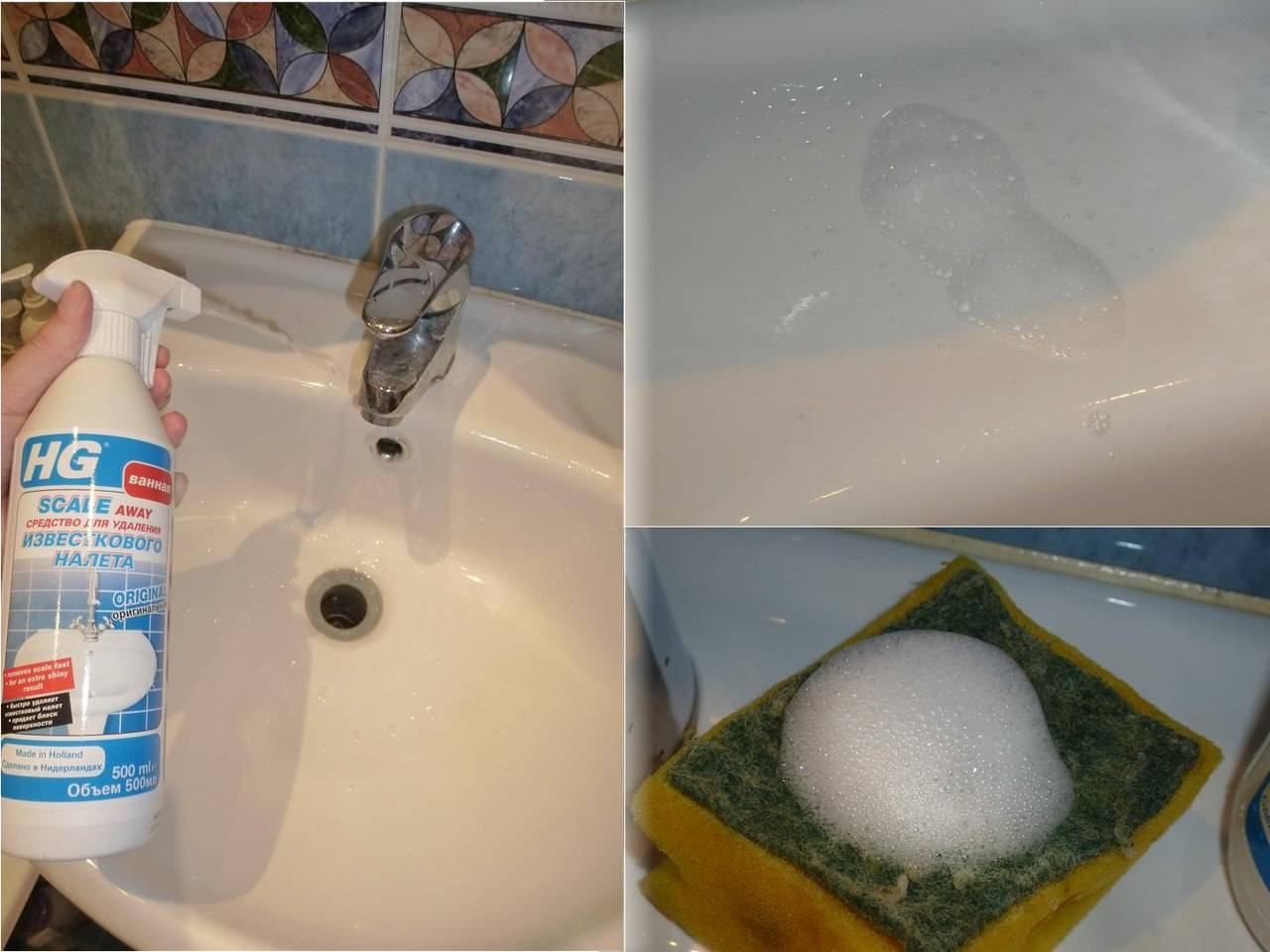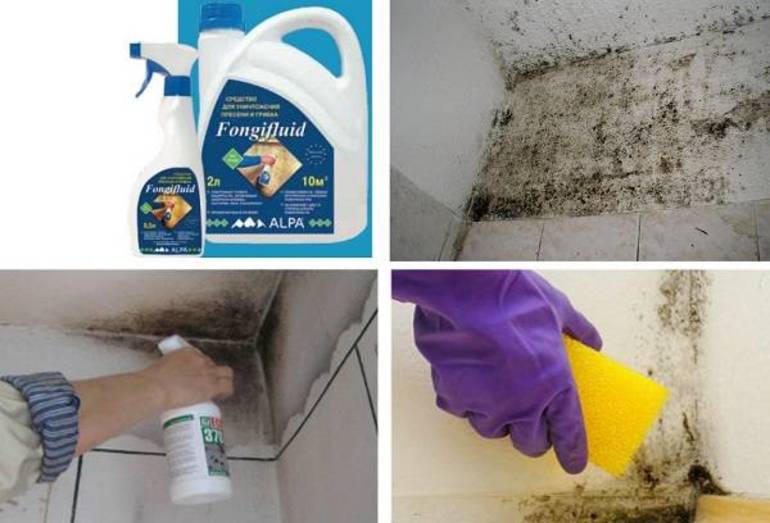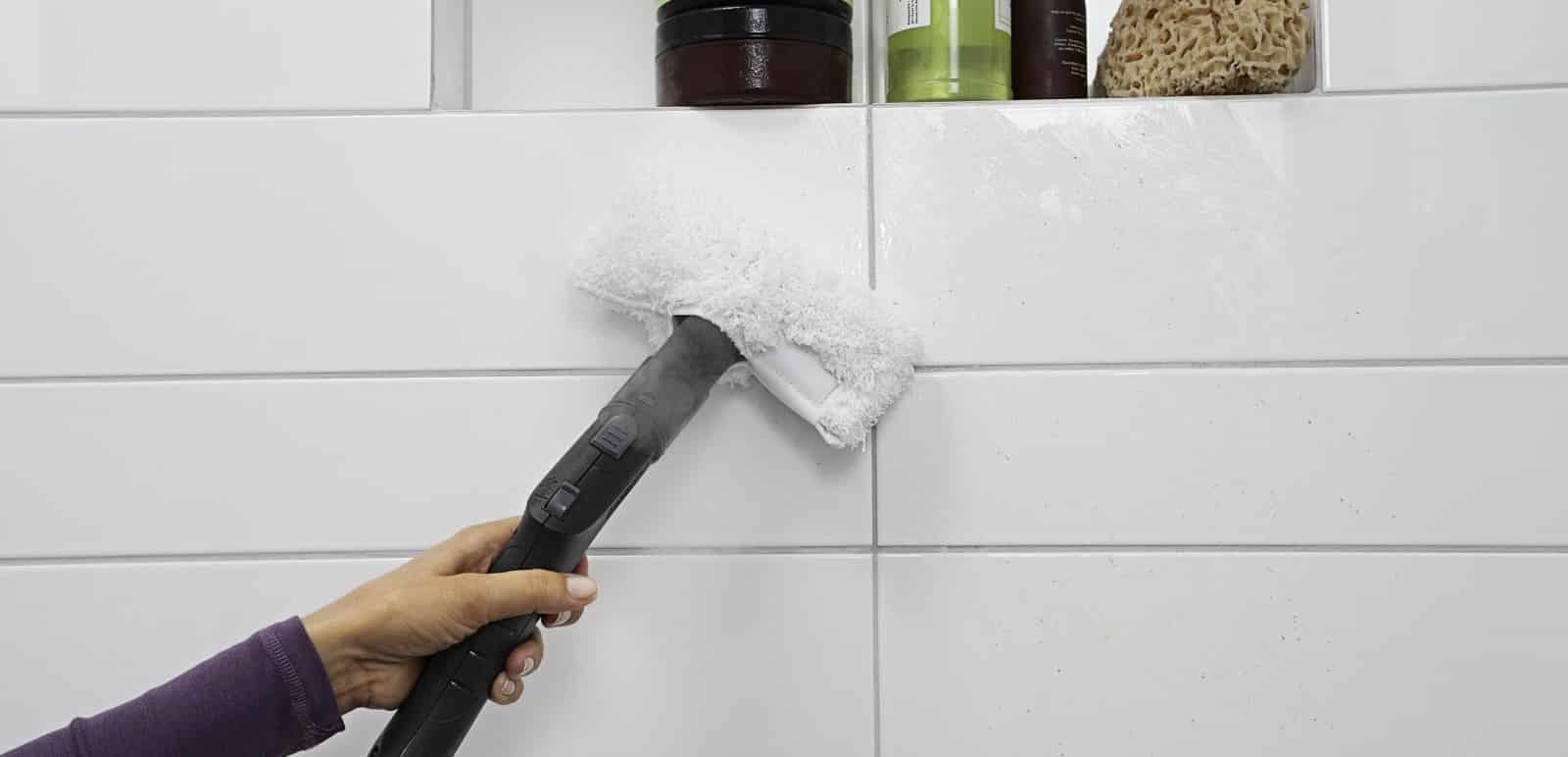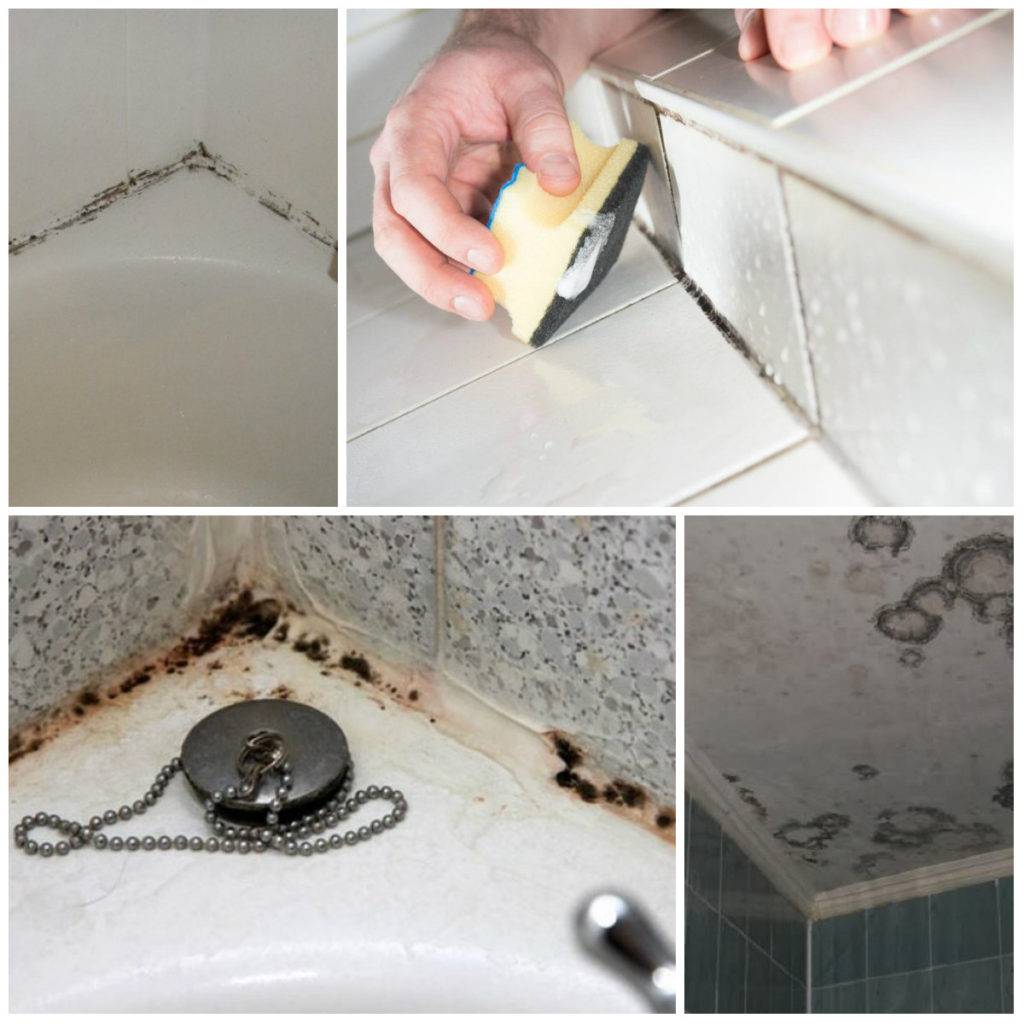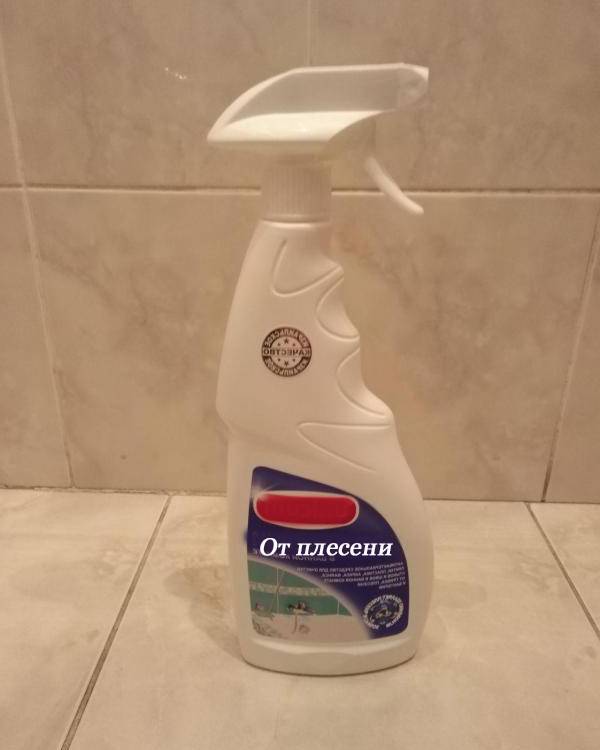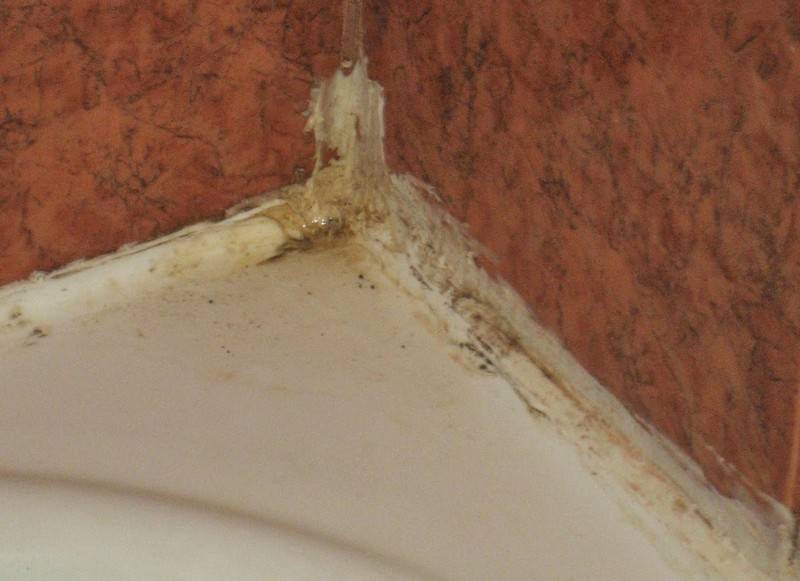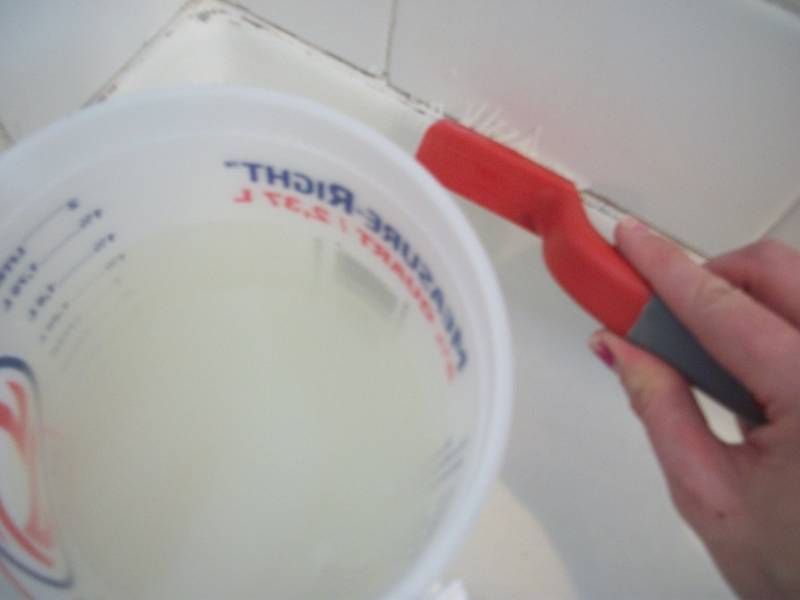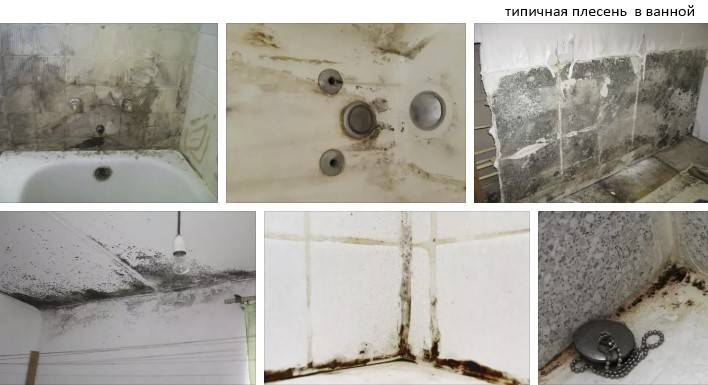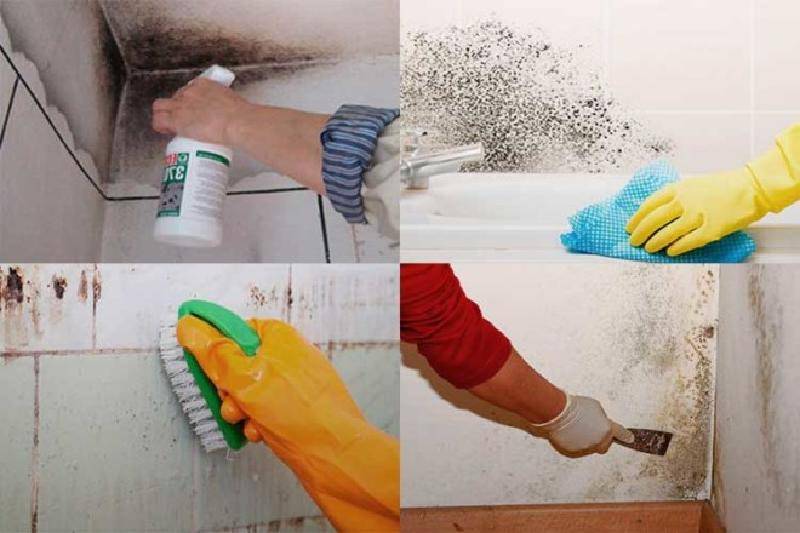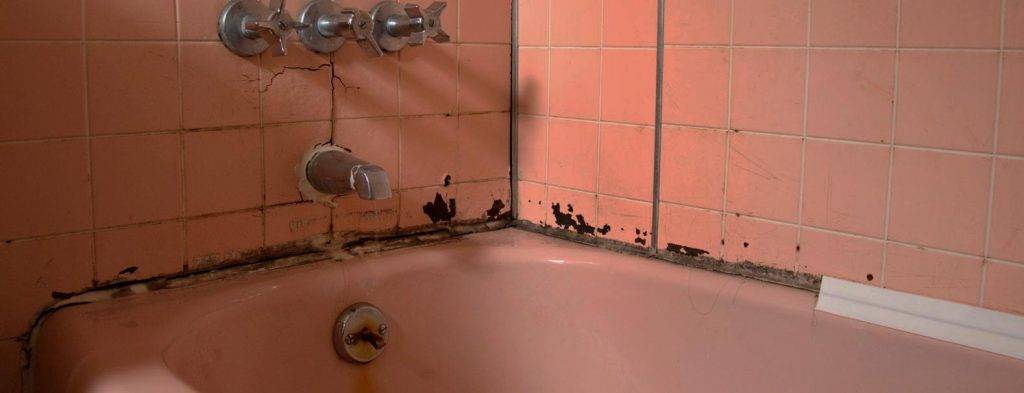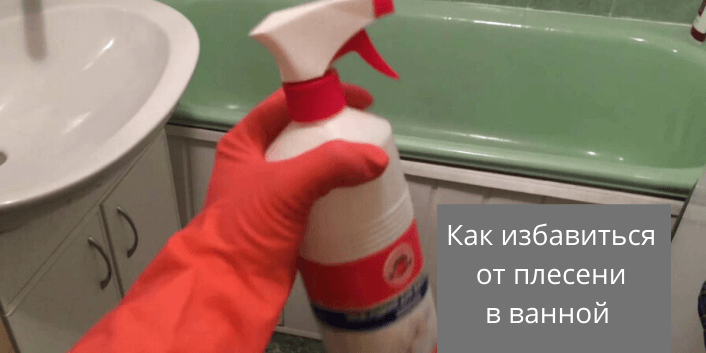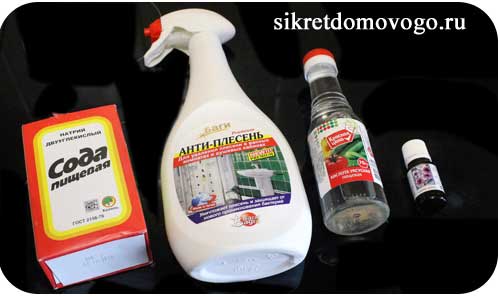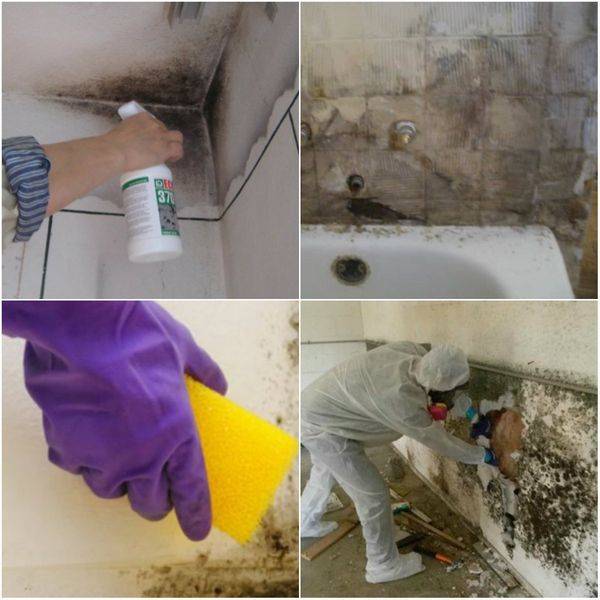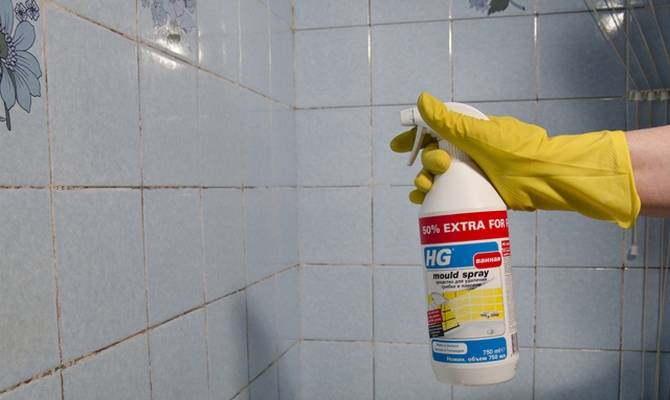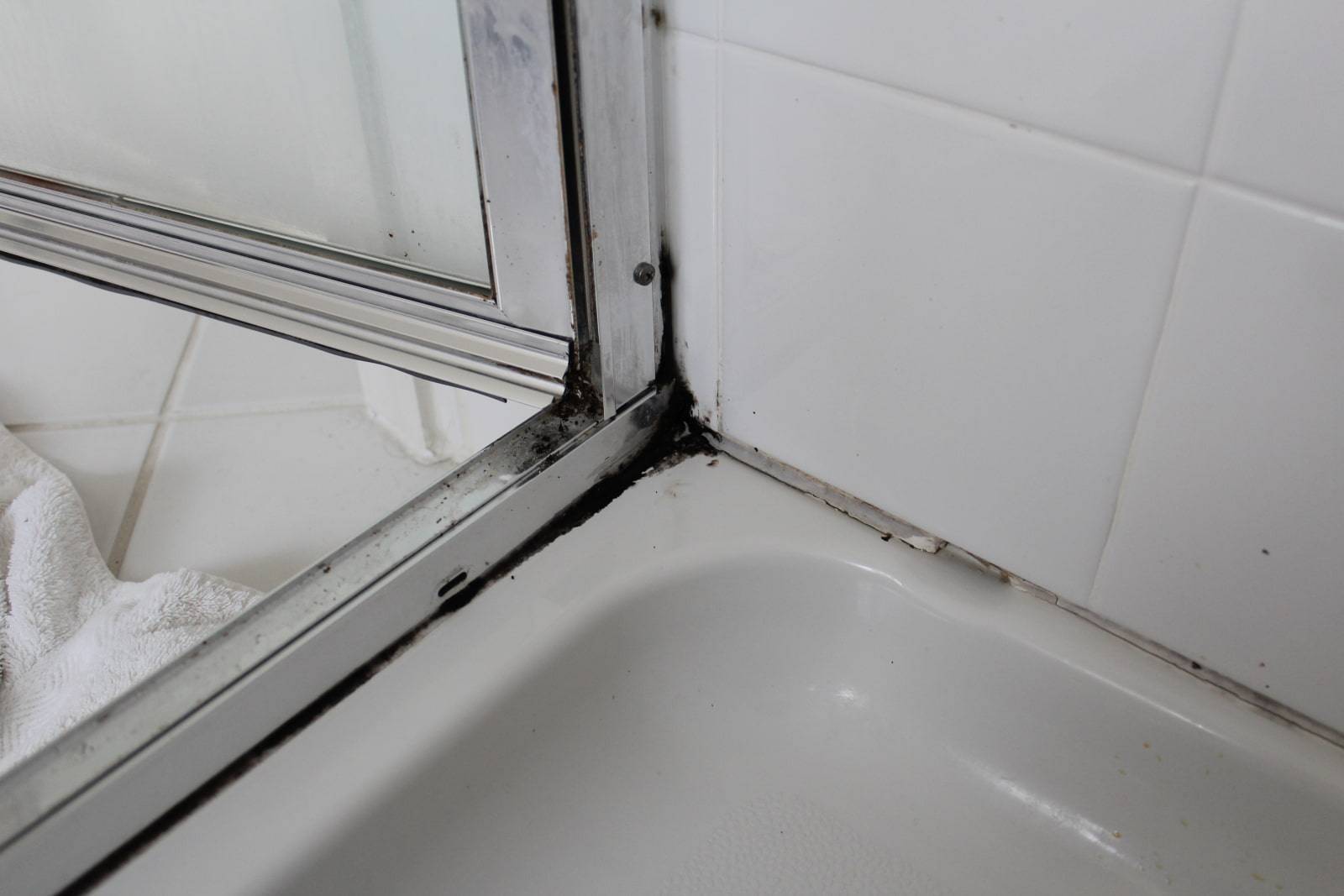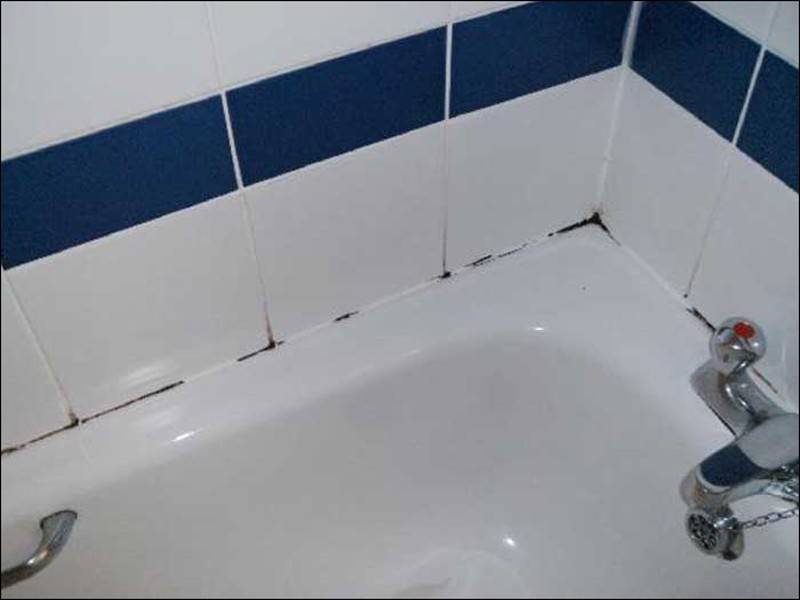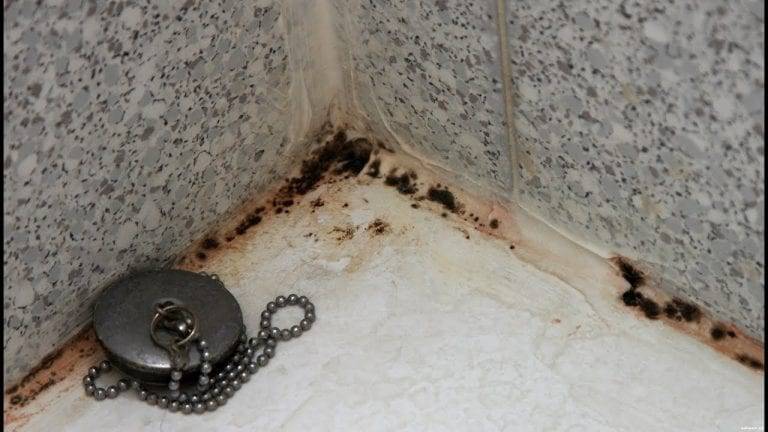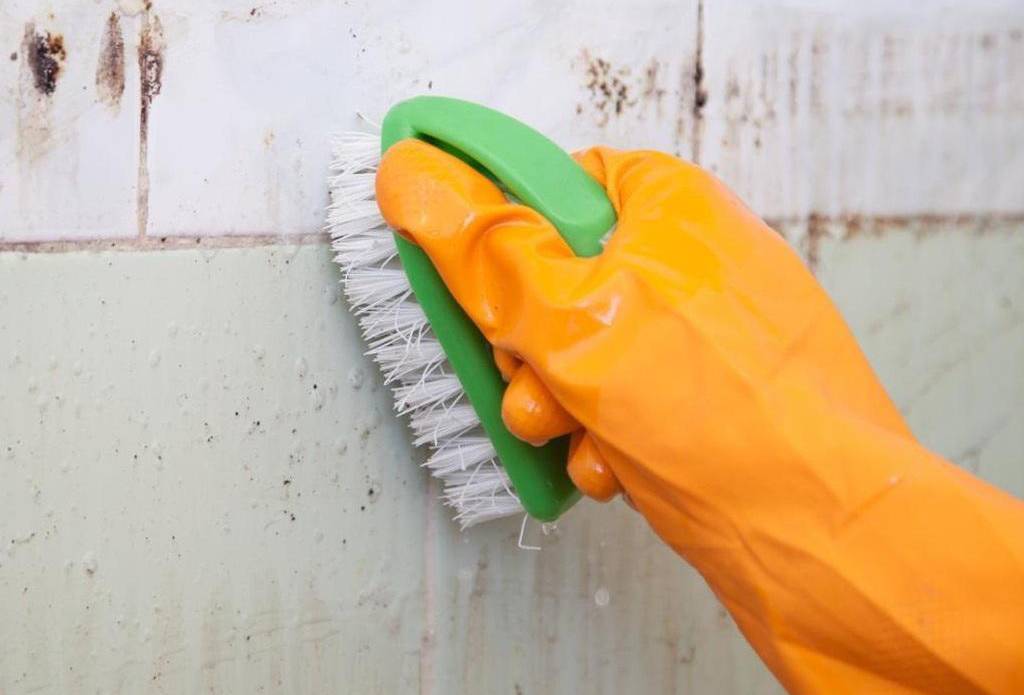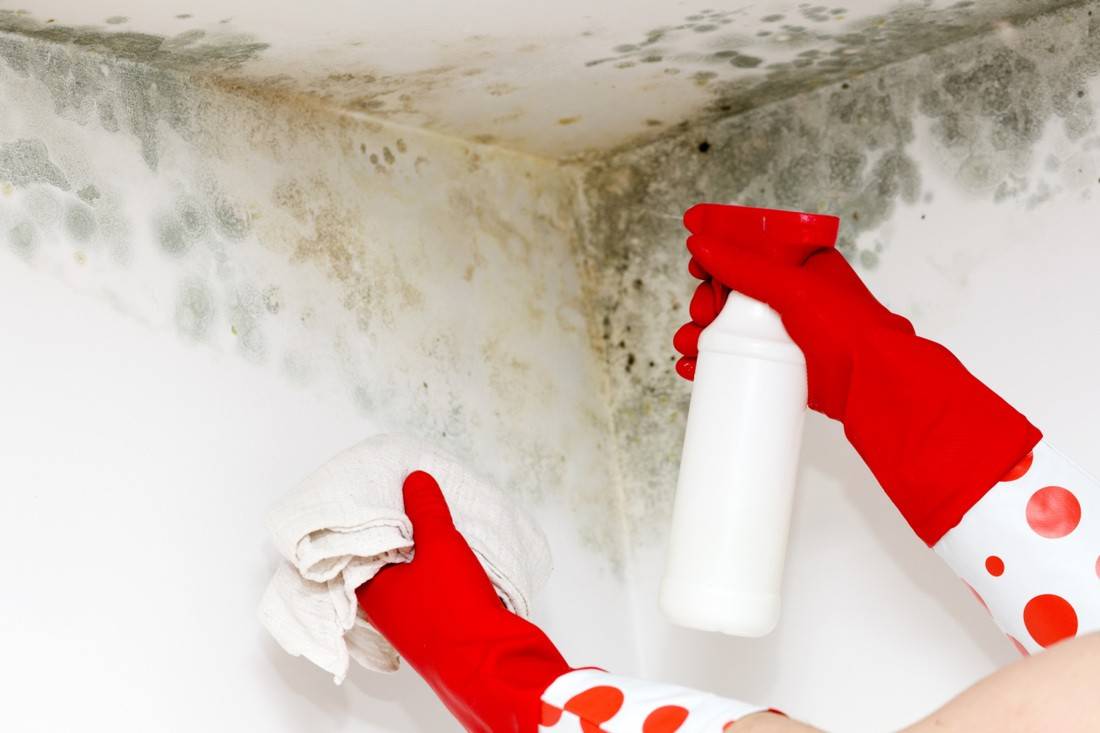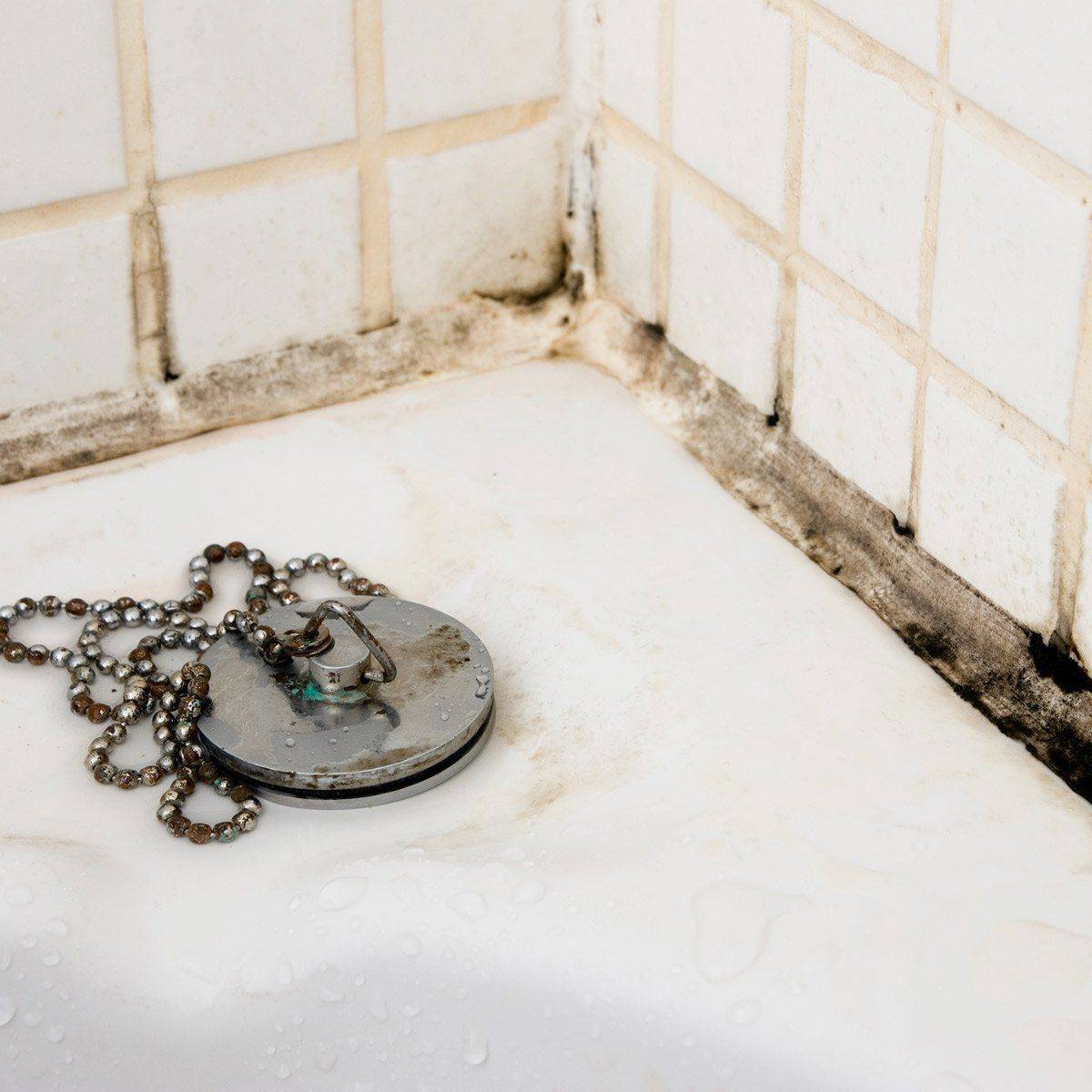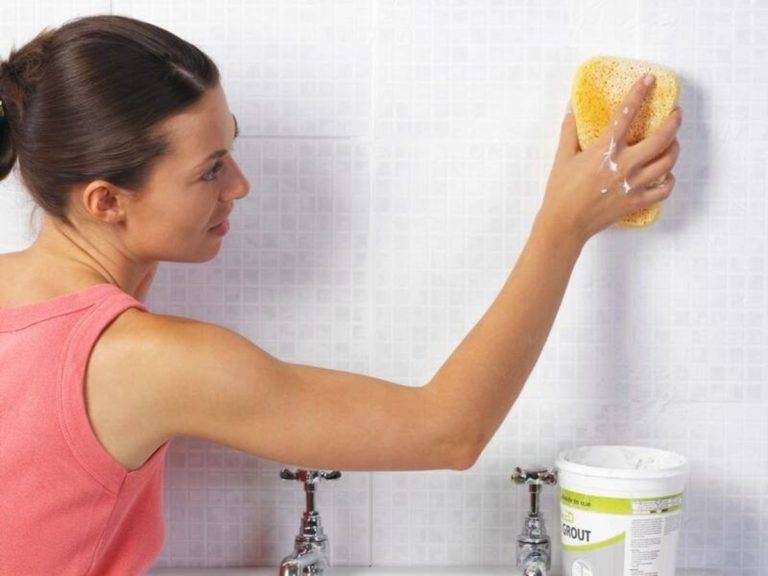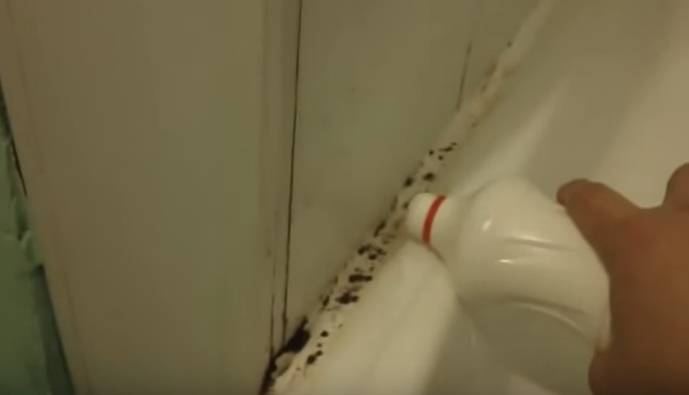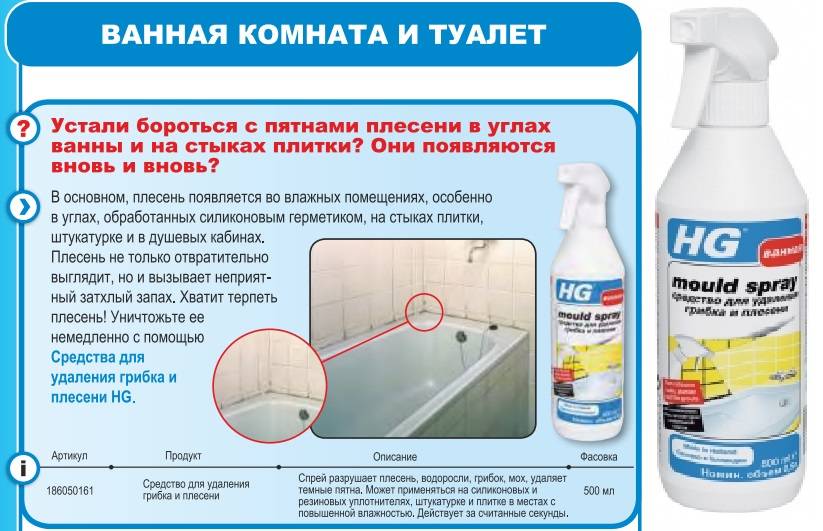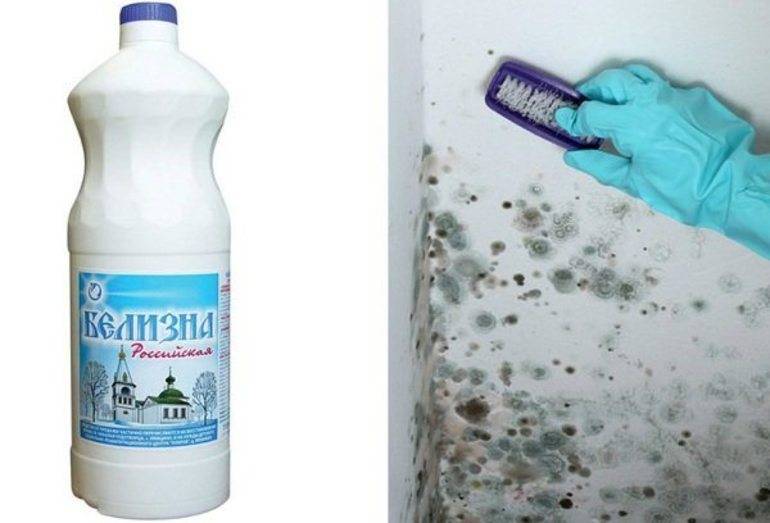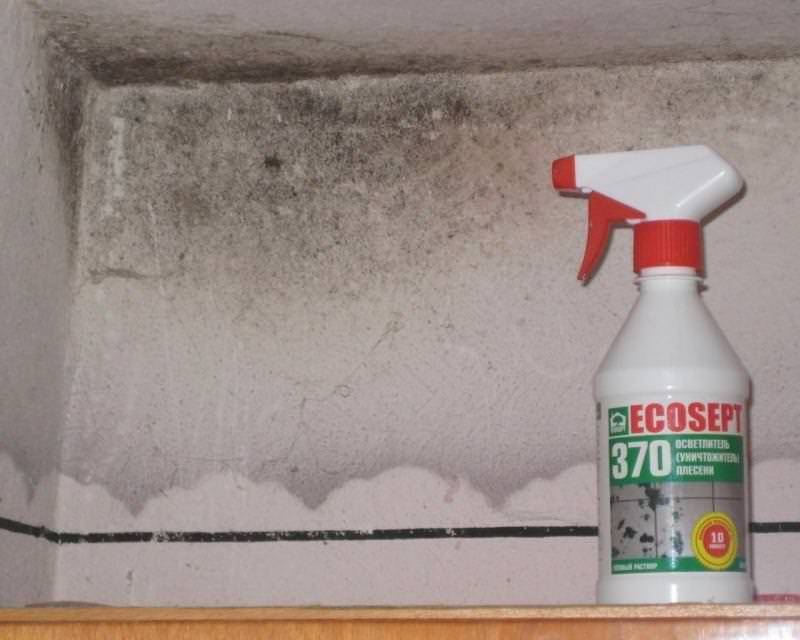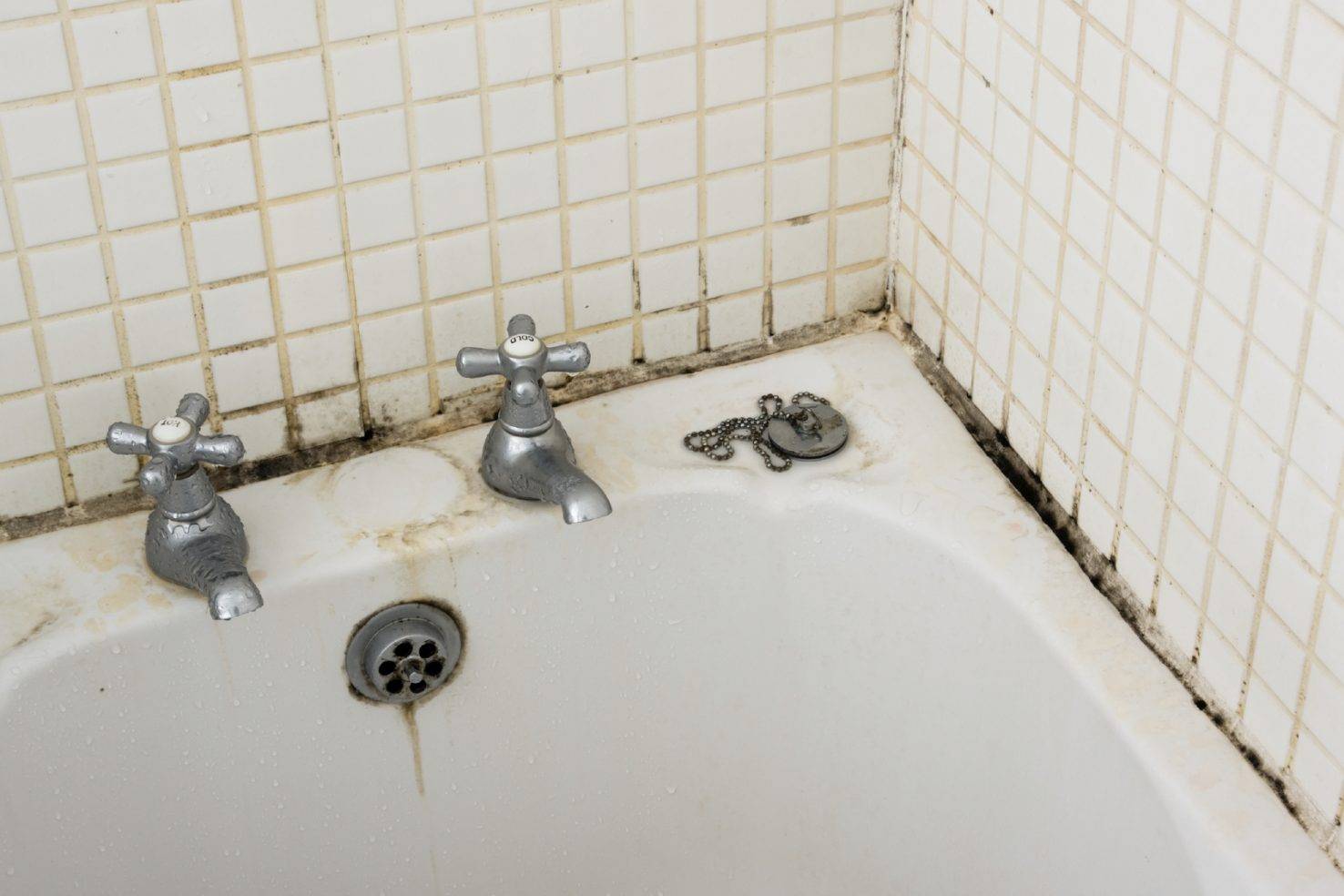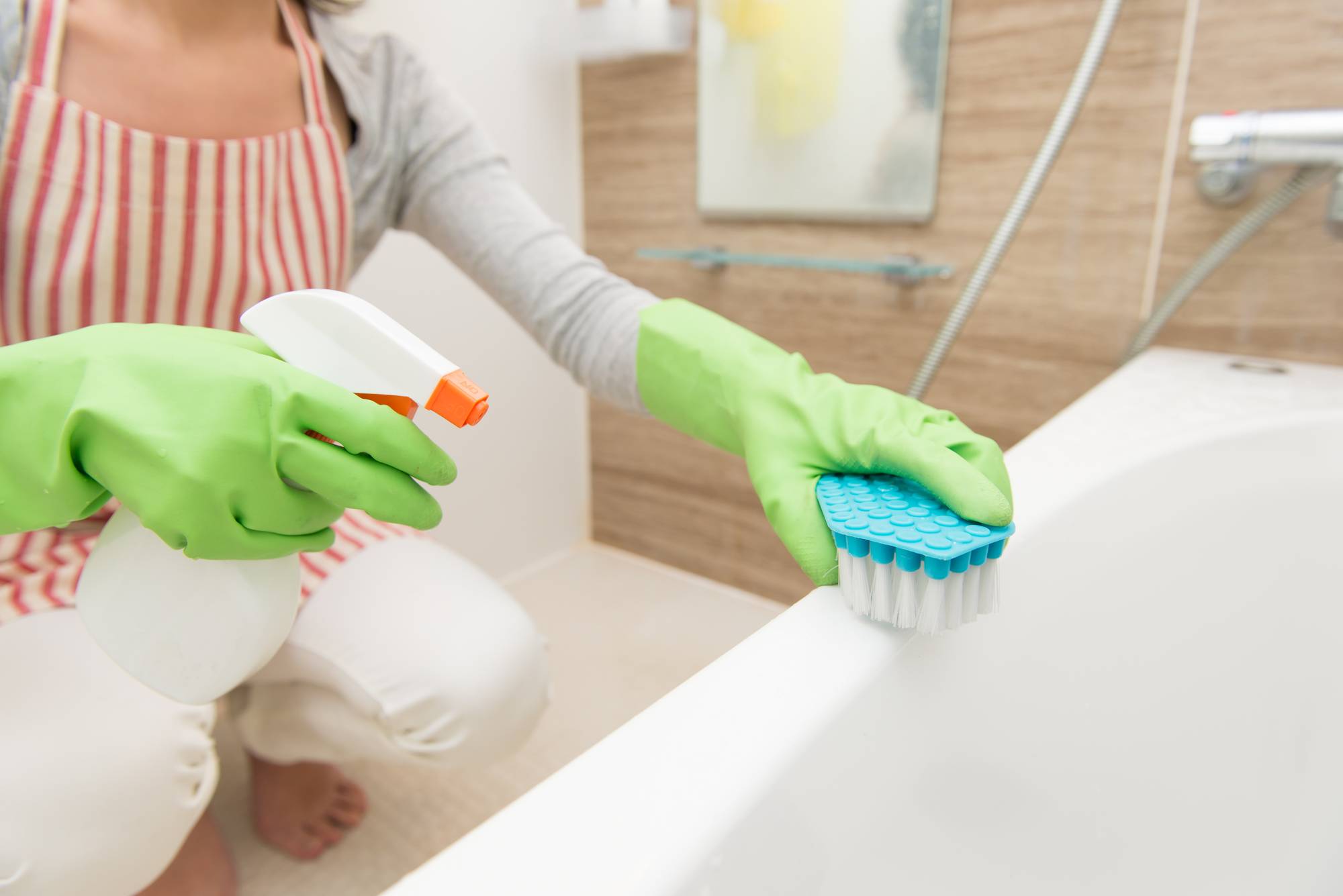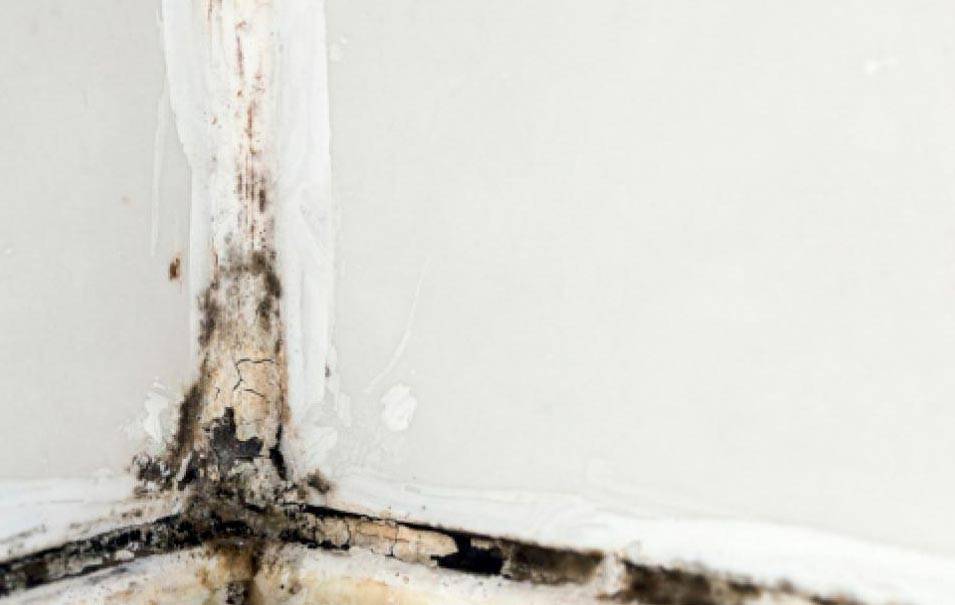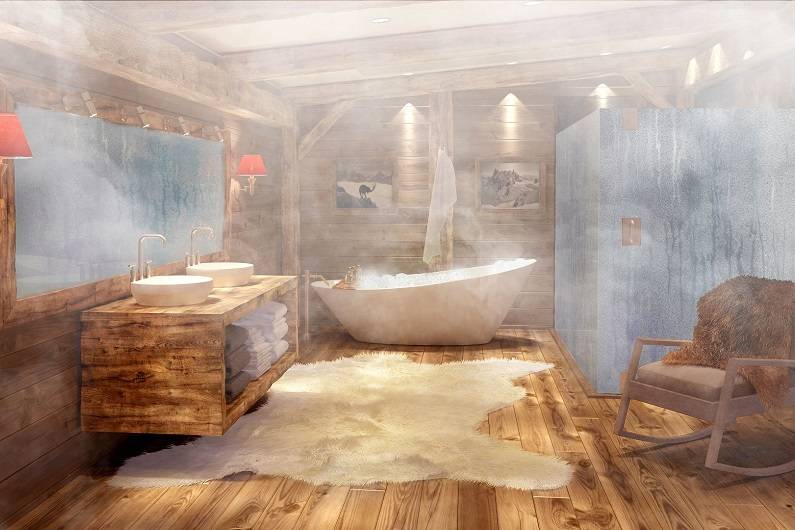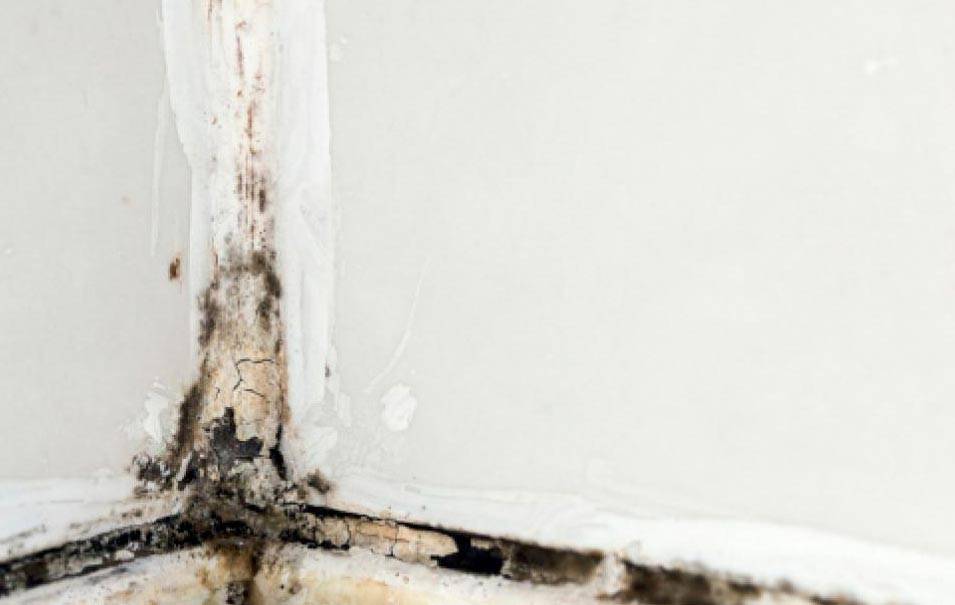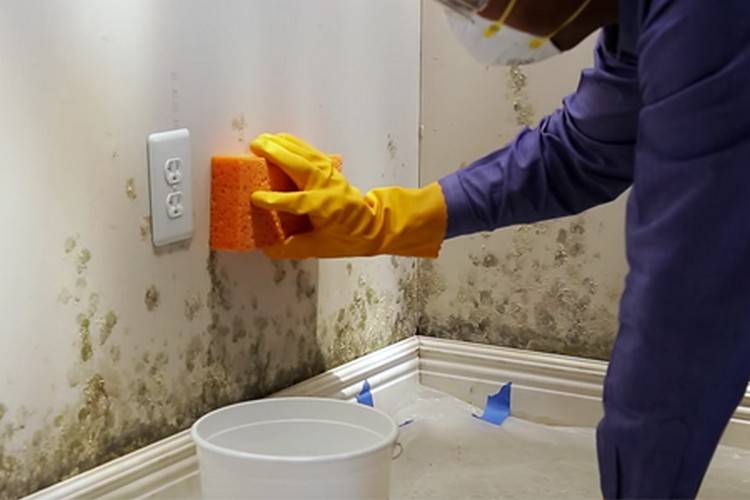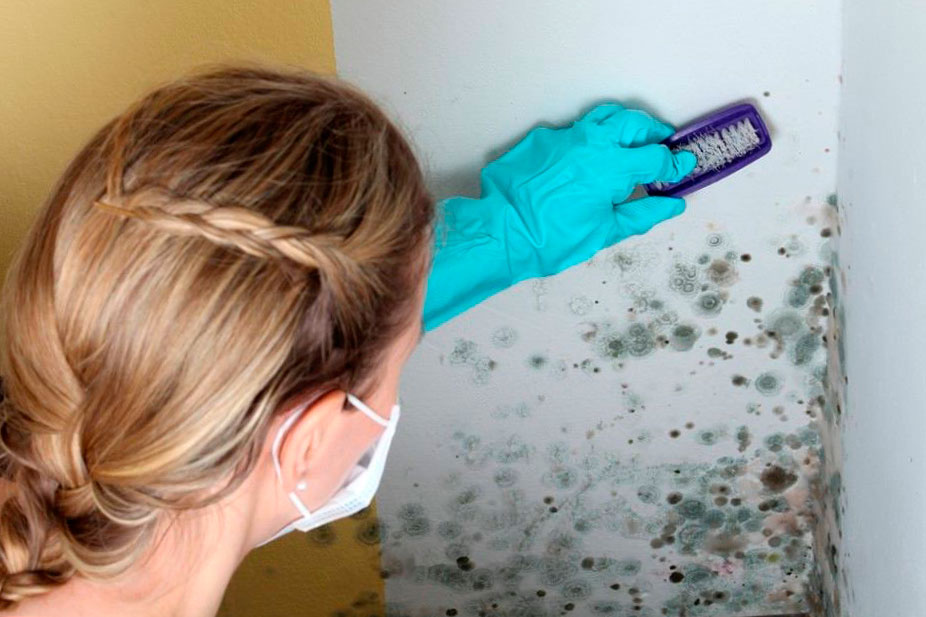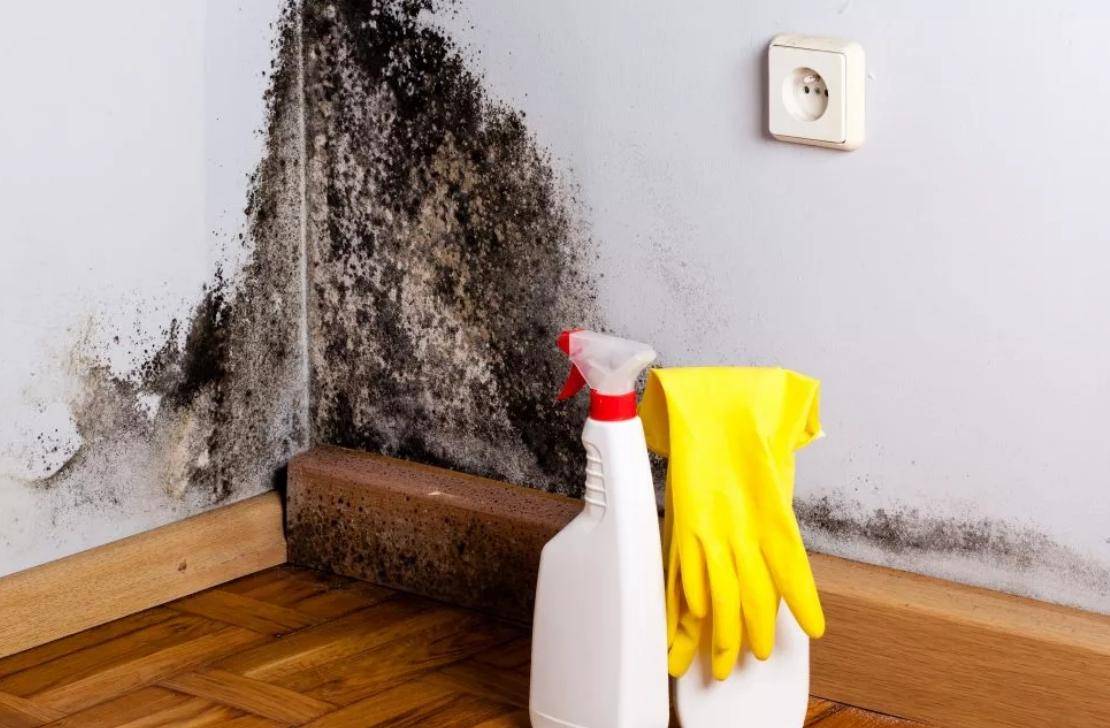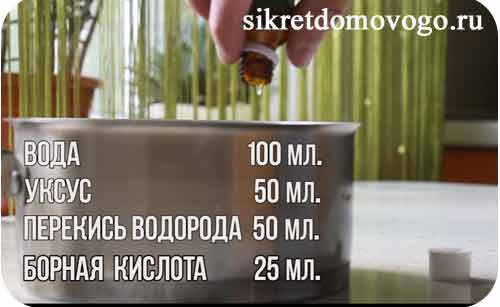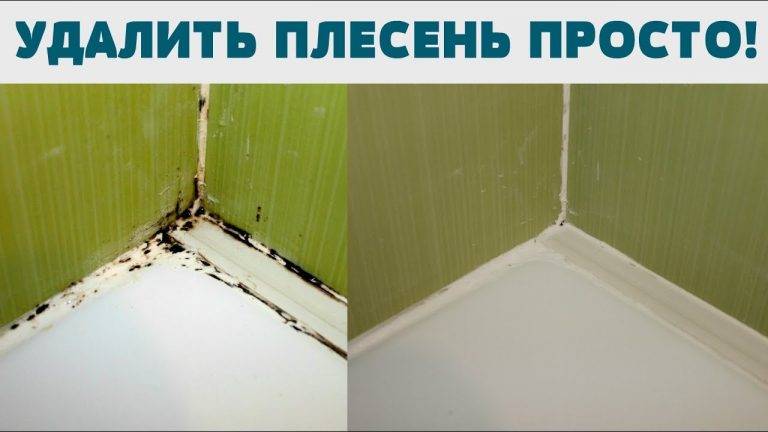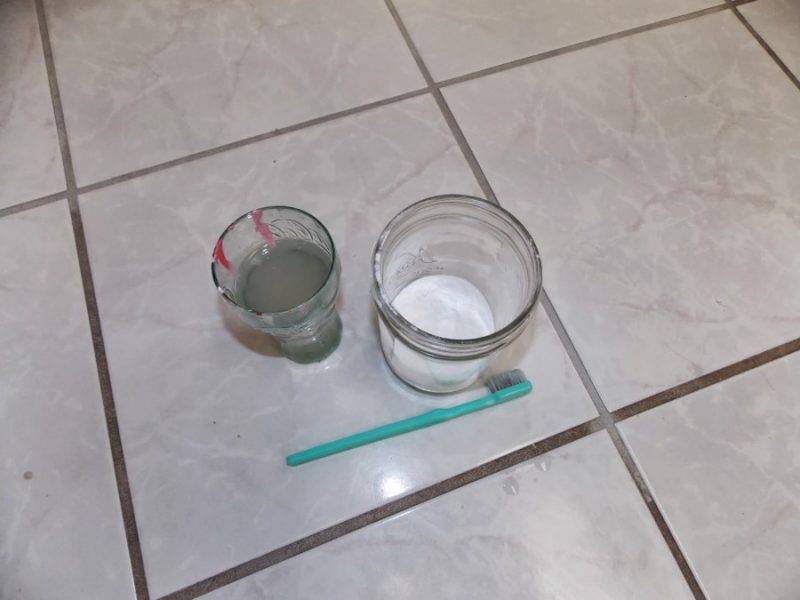Methods for cleaning seams using household chemicals
This method of removing dirt and mold from seams cannot be called completely safe: some household chemicals are quite toxic, therefore, when treating the surface, you need to protect the respiratory tract, eyes and skin of the hands from their adverse effects.
Special means
At any hardware store or hardware store, you can find a product specifically designed to remove mold and mildew from any surface. Sodium hypochlorite is usually the active ingredient in this kind of product. He then has a detrimental effect on microorganisms and prevents their reappearance.
An industrial product does not have to be in a liquid form: you can purchase a special felt-tip pen that will help you easily cope with unsightly plaque in the tile seams. The felt-tip pen is excellent at dealing with fungus and thoroughly cleans dirt from hard-to-reach gaps.
White
Whiteness is a popular and inexpensive chlorine bleach that can be used to kill mold. This tool has a powerful effect on the fungus precisely due to the high concentration of chlorine contained in it. "Whiteness" is used undiluted, it is applied to damaged areas, kept for some time, then be sure to thoroughly rinse with water.
Bleaches
Oxygen bleach is, in this sense, a safer mold-fighting agent. Usually it is diluted in a 1: 1 ratio, then applied to the seams between the tiles, kept for half an hour to 40 minutes. Oxygen molecules penetrate into the grout, affecting harmful microorganisms.
Further, mold and dirt will need to be thoroughly cleaned with a sponge or a used toothbrush, then rinsed with water and wiped dry.
Risk-free cleaning
Many people are worried about how to remove fungus in the bathroom. At the same time, the methods must be non-aggressive and safe. You can use the following tips.
Soda and vinegar. An effective and cheap tool. Ingredients can be found in almost any home. The essence of the method is as follows:
- The soda is slightly moistened with water to form a paste.
- The resulting product is applied to the affected area.
- After that, a few drops of vinegar are slowly poured onto the paste.
- After the formed foam has settled, everything is washed with warm water and wiped dry.
The method is harmless and does not require the removal of household members from the apartment.
Boric acid and acetic essence. Before work, you should wear rubber gloves and follow the instructions:
- Prepare a solution. For this, 4 parts of water, 2 parts of hydrogen peroxide, 2 parts of boric acid and one part of vinegar essence are taken.
- Use a brush to treat all affected areas.
- Leave to act for 3-4 hours.
- Rinse thoroughly with warm water and wipe dry.
After using the product, it is necessary to ventilate the room.
4 Alternative methods of control
Ionization and air sanitation are expensive but very effective methods. The principle of operation lies in the fact that an air jet is supplied from a special device to the required place, containing a rich set of trace elements, ions and other components that actively fight infections and bacteria. The method is also effective against rodents and domestic insects. But it is better to entrust such disinfection to a professional.
In a situation of deep penetration of moldy spores (under the finishing materials and into the seams between them), you should remove all the tiles (any other coating), thoroughly ventilate and dry the room, and only then start treating with an antiseptic.
It is always easier to prevent a nuisance than to make much greater efforts to eliminate it later, therefore, there are preventive measures.
An indicator of a lack of ventilation in a room is considered to be high humidity.Therefore, it would be good to ventilate such a space or place an exhaust fan in it and clean the ventilation shaft. The presence of traction can be experienced by simply bringing up a lighted match or a piece of paper.
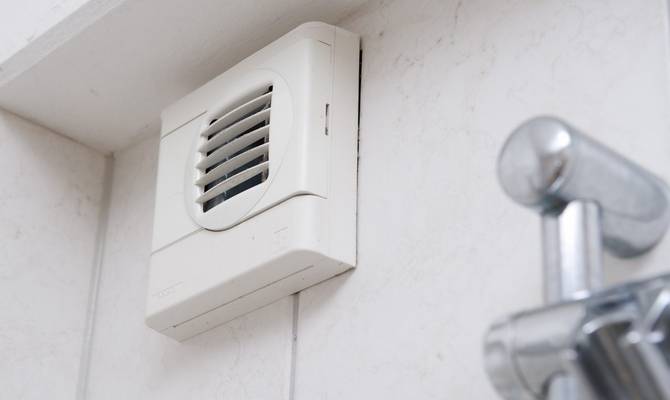 Installation of a high-quality ventilation system
Installation of a high-quality ventilation system
It is also worth examining all plumbing devices for their serviceability. Anything can become a source of increased humidity: both a leaking tap and the resulting condensation on the riser. Therefore, any slightest disruption in their work will have to be eliminated.
When planning a bathroom renovation, you should consider providing a reliable waterproofing solution. To some extent, this measure will also help prevent the appearance of fungus and mold.
Also, check how the towel dryer does its job of heating the air. If its capacity is not enough, then perhaps it's time to change it.
A radical way to fight
The mycelium is usually located under the plaster, so thorough repair work cannot be avoided.
- It is necessary to remove all layers of finish, carefully scrape off the fungus from the surface.
- Using a construction hair dryer or a household heater, you should warm up and dry the cleaned places well.
- Next, you need to treat the surface with an antifungal agent or antiseptic and once again warm up the bathroom well.
- After the work done, you can start finishing.
What to do if the scale of the upcoming work scares you or you do not have enough experience in finishing work?
In this case, you can call for the help of professionals specializing in the elimination of mold. It will be faster, more reliable, and will not worry about the re-growth of the fungus.
How to protect
To protect the premises from mold, it is necessary to fight against the phenomena that contribute to the appearance of fungus:
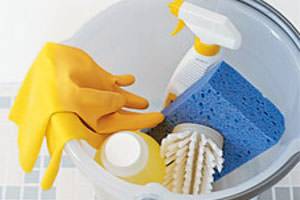
- Ventilate the room regularly, preferably install an exhaust fan.
- Provide good quality waterproofing of the pipes.
- Monitor the health of the plumbing fixtures.
- Install a powerful heated towel rail.
- In the event that the walls in the bathroom are in contact with cold air, for example, the bathroom wall is in contact with the staircase, which is poorly heated, spend money on insulating the bathroom wall from the inside.
- Remove cracks in the wall.
- Clean the ventilation regularly.
- Install underfloor heating in the bathroom.
So, the appearance of mold in the bathroom is an unpleasant fact. Do not delay getting rid of it, otherwise it can be detrimental to your health!
Modern remedies help to remove the fungus in a short period of time. Preventive methods can help prevent mold from reoccurring in the bathroom.
2 Folk methods of dealing with moisture
How to treat surfaces in humid conditions and remove fungus in the bathroom? You can try using folk remedies. The following are ready-made recipes, which include home remedies that are always at hand for any caring housewife.
Baking soda for mold and mildew. There are several options for how to use baking soda to remove mold from your bathroom. Method one: before removing the mold with a sponge or brush and washing off the contamination with water, the affected areas are treated with a soda solution using a spray bottle. The solution is prepared as follows: half a tablespoon of soda is thoroughly stirred in two glasses of water. After sprinkling the cleaned surface with the agent again, let it dry on its own. The second method involves applying a generous amount of baking soda to moldy surfaces. Vinegar is added to the soda, which is simply poured over the soda powder. The foam is allowed to settle and the treated area is thoroughly washed with hot water in which the detergent is dissolved, after which it is wiped off until completely dry.
Copper sulfate is quite effective in the fight against mold.Treatment of the affected surfaces with this tool is performed with a special brush.
When working with it, you must follow the precautions, exactly following the instructions.
Bleach solution. A saturated solution of bleach will help in getting rid of moldiness on the walls.
However, this substance has one drawback - a pungent and long-wearing smell. Bleach is found in products such as chlorine bleach. Therefore, it can also be successfully used by dissolving 100 ml of the substance in a bucket of water beforehand. You can also use bleach.
Bura. Outwardly, it resembles a white powder. Borax is considered a fairly safe way to remove mold. Before wiping the treated area with a dry cloth, it is first cleaned of dirt, and then with a solution (1 liter of warm water and half a glass of borax), using a paint brush, lubricate the prepared area. Do not wipe dry, but only try to remove excess smudges.
Tea tree oil. The recipe for the composition is simple: 2 teaspoons of this oil are diluted in two glasses of warm water. The resulting mixture is filled with a room sprayer and all unsuccessful places in the bathroom and toilet are treated. In this way, even processing the ceiling is not difficult.
Vinegar or acetic acid. The working mixture is prepared as follows: mixed with 4 tbsp. l. water 2 tbsp. l. vinegar, hydrogen peroxide (2 tbsp. l), boric acid (1 tbsp. l). With a cloth, apply the mixture to the damaged areas and wipe dry.
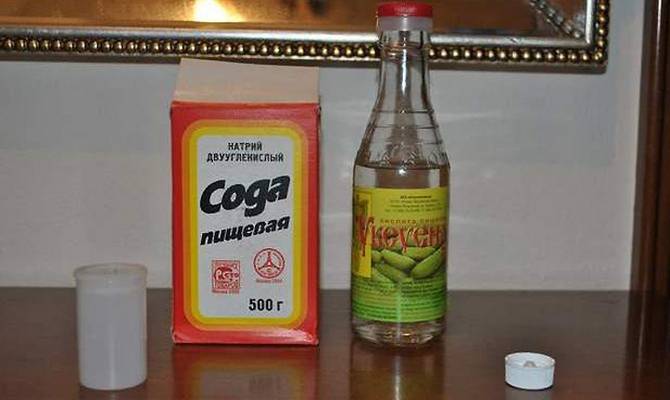 Baking soda and vinegar against mildew
Baking soda and vinegar against mildew
Other methods of fighting mildew and mildew include:
- Reservoirs are filled with an aqueous solution of iodine and placed in places where blackness accumulates.
- Camphor balls are laid out everywhere on the shelves and any surfaces convenient for this.
- Anthracene oil and steam cleaners will help to cope with the task.
Folk methods
There are also alternatives to chemical compounds.
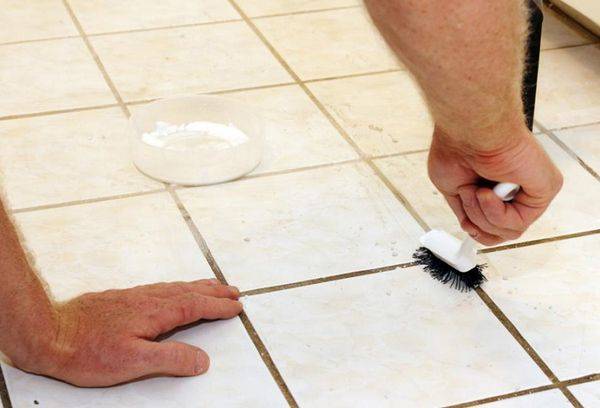
They are non-toxic and also effective when used at home:
- Bura. A solution is prepared from this product of natural origin by mixing with water in a ratio of 1:10. The product is applied to the affected area with a sponge or hard brush, cleaning the surface chemically and mechanically at the same time. After drying, the composition is not washed off, only wiped with a soft cloth - a layer of dry borax prevents the growth of mold.
- Vinegar. Not all types of fungus succumb to it; vinegar is often used for preventive purposes. Concentrated acetic acid is applied undiluted, left for an hour and washed off with water. Regular, after 2 weeks, treatments are recommended.
- Soda. It is a food safe substance for health. For the treatment of seams and other surfaces, an aqueous solution is prepared (1 tablespoon of soda per glass of water) and poured into a spray bottle. The agent is sprayed, left for a while and the mold is cleaned with a hard sponge or abrasive paper. Dust, dirt with fungus is washed off with water and re-treated with a soda solution.
- Soda and vinegar. To remove mold from lesions with severe damage, soda, slaked with vinegar, is used. Soda is liberally applied to the area with the fungus, and vinegar is applied on top. After waiting for the end of the reaction between the acidic and alkaline components, the surface is washed with soapy water or detergent.
- Tea tree oil. This essential substance has antibacterial and antifungal effects and is used in aqueous solution to remove mold. The composition is prepared by adding 1 teaspoon of oil to a glass of water. The affected areas are treated and left, no further action is required.
- Grapefruit seed extract. Very little of this antiseptic is needed - 10 drops per glass of water. The solution is appreciated for its safety and absence of unpleasant odors. It is necessary to apply the agent several times to obtain a disinfectant effect. Prepared, but not used, the solution is stored for a long time.
- Hydrogen peroxide. The medicine is applied with a small rag.After drying, the affected areas are cleaned mechanically and washed with water.
- Complex composition with boric acid. Effective treatment of areas with mold with a solution of 1 part of boric acid, 2 parts of table vinegar and the same amount of hydrogen peroxide in 4 parts of water. The agent is slightly warmed up and applied to the tile joints, and after 30-40 minutes the work area is washed.
- Ammonia. The solution is prepared by combining 7 ml (1 teaspoon) of the substance with 2 glasses of water and 10-15 drops of tea tree essential oil. The seams are treated with the prepared agent, kept for half an hour and washed off with water.

The best way to remove mold
Sometimes black mold spreads so much over the surfaces of the room that it can be very difficult to get rid of it. There is a proven method by which you can clean the room from mold once and for all. To this end, all old bathroom coatings are removed completely, leaving the ceiling, floor and walls completely bare, after which the room is dried using a powerful hot air blower.
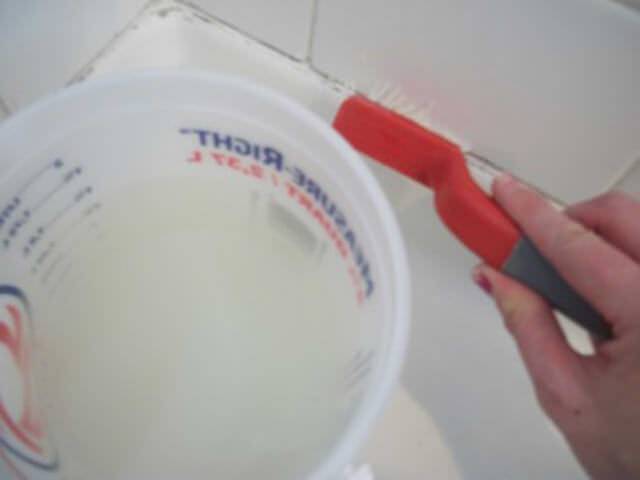
When all surfaces are completely dry, an anti-mold and mildew agent is applied to them. It is necessary to ensure that literally the entire treated area is reliably saturated with a disinfectant. Since the drug is toxic, the procedure must be carried out, reliably protecting the eyes and hands from the ingress of toxic splashes. After some time, the premises are repaired: all surfaces are freshly coated, and to prevent the reappearance of mold, the surface must be treated with a special antiseptic. The most common way to renovate a bathroom is tiling. It is possible to eliminate mold in the bathroom with this method for a long time, although it takes quite a lot of time and effort.
Ways to fight
Mold on walls, ceilings or bathroom furniture significantly impairs the appearance of the room, leading to accelerated wear and tear on the finishing materials. Many housewives are wondering what is the best way to get rid of the fungus in the bathroom once and for all. Having tried numerous expensive store products, processing with which gives only a temporary result, many are trying to fight mold with folk methods.
Fungus treatment
To do this, use vinegar, ammonia or hydrogen peroxide. It turned out that as efficiently as possible, you can quickly get rid of the fungus on the walls and ceiling in the bathroom in the following ways:
- You can remove the fungus from the surface of the walls with a simple folk remedy using vinegar. There is always vinegar or vinegar essence on the farm. You need to pour vinegar inside a spray bottle or apply to a cotton swab, and then treat the surface of the walls with it. After a few hours, the vinegar will dry out, then the treated area needs to be brushed. However, vinegar is effective in only killing 80% of the fungus.
Vinegar
- You can use creosote to remove mold from wall surfaces. It is a pungent, oily, tar-based substance with a pungent odor. But it was used to protect sleepers from rotting. Creosote must be dissolved in alcohol, and then treated with the affected area of the wall. After use, the treated surface is thoroughly cleaned. Work with creosote using a respirator and gloves. This product is not suitable for wood surfaces, which are highly absorbent.
Creosote
- To remove the fungus, you can use ordinary hydrogen peroxide, which can be found in any medicine cabinet. It is a proven anti-mildew agent and is suitable for tiles, plastic or bricks. However, peroxide has a pronounced whitening effect, so it can only be used on dark surfaces.
Hydrogen peroxide
Treatment of seams in the bathroom from mold
The scale of work depends on the state of neglect of the bathroom. One of the most important steps in the fight against mold is mechanical processing.It is recommended to combine it with other methods.
Mechanical method
With a shallow penetration of the fungus into the building mixture between the tiles, it is enough to walk with a fine-grained abrasive. The formed dirt with mold is washed off with water.

A more serious situation, when the grout is deeply affected by the fungus, requires, in addition to processing with sandpaper or a hard sponge, also removing the layer of the mortar. Seams with a touch of mold are cleaned with a screwdriver with a straight slot, a nail, a spatula, and other devices until the fungal trail disappears.
The work surface is cleaned of dust, treated with fungicide from mold or vinegar and allowed to dry. For new seams, choose a moisture-resistant, preferably on a sealant, composition with an anti-fungal effect. They, using a spatula, fill the tile joint. In a day, when the grout sets well, the seams should be additionally treated with an antifungal composition of deep penetration.
Hot steam
This method requires a household steam cleaner. Steam treatment of joints in the bathroom against mold is effective due to the high temperature and pressure. Under the influence of steam, powerful cleansing takes place, and dirt with mold is removed outside. The method is interesting because of its safety: no chemical, or any, means are required. Processing is carried out quickly, the surface after exposure to steam only needs to be wiped off.
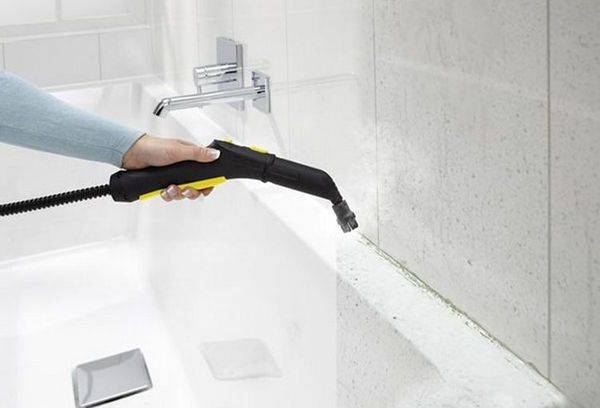
Using electromagnetic radiation
High frequency sources of electromagnetic radiation can be used to remove mold from individual areas. Processing is carried out pointwise, which is convenient when etching tile joints. Under the influence of microwave radiation, mold is effectively destroyed.
Chemical compositions
One of the most effective means to get rid of mold on tiles and in tile joints is an aqueous solution of copper sulfate. It is prepared using the proportion: 100 g of substance - 10 liters of water. Tile joints are treated with a brush, generously impregnating the building material with mortar. After a few hours, letting the composition "work", the surface is washed and allowed to dry.
Most often, an aqueous solution of bleach with chlorine is used in everyday life. Work on applying the composition is performed in personal protective equipment: gloves, a respirator. The surface is treated with a rag or brush, sponge, spray. A solution is prepared using 10 parts water and 1 part bleach.
Manufacturers also produce household chemicals that contain chlorine ("Whiteness", Domestos, "SiF", "Silit", others). Chlorine-based products have worked well in the fight against mold. They, by removing the fungus, also disinfect the surface. Mold after processing them does not appear for some time.
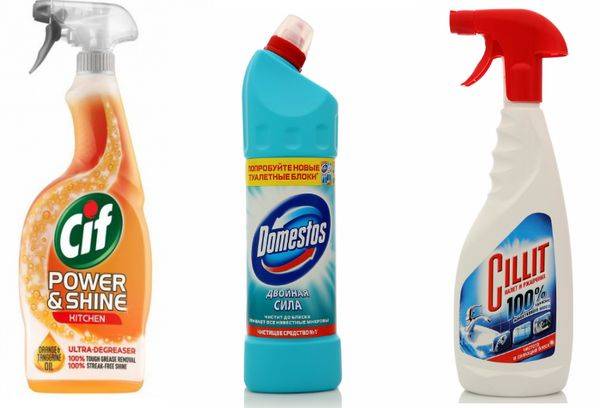
There are also specialized fungicides for mold. For example, "Anti-B", which kills mold on any surfaces, by the Russian manufacturer "Atom-Color". Before using it, the surface must be mechanically cleaned. Other means of this series are Fongifluid from Alpa (France), Renogal from Schomburg (Germany), antiseptic Dali (Dali) of domestic production. Before applying them, you need to read the instructions - fungicides differ in both preparation and use.
How to get rid of forever
If you want to get rid of mold in your bathroom for good, you will have to start a full renovation. It is necessary to remove all the finishing along with the plaster. Bare walls - concrete or brick - must be treated with a primer with antibacterial properties (there are some), when plastering, you can use a composition with antifungal additives or add it to a standard cement-sand mortar yourself. After the plaster has dried - a primer, then tiling using antifungal adhesive. Even the grouting must have the appropriate properties.
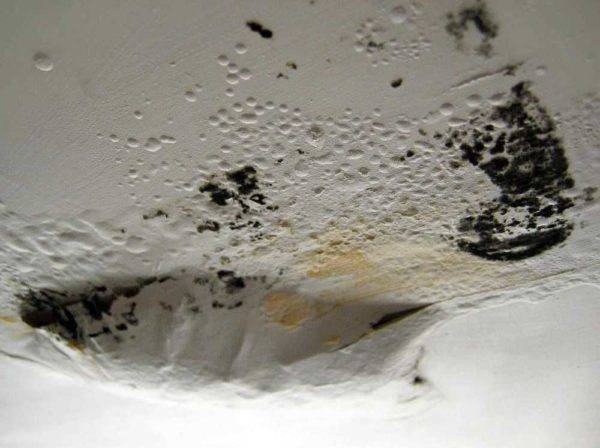
Fungus is not only not a surface. His spores inside the wall
With this state of affairs and normally working ventilation, you will no longer have problems with mold and mildew.All other methods allow you to get rid of mold in the bathroom only for a while.
Below is a description of some of the tools you can use to combat mold and mildew during bathroom renovations. The same means can be used to process already finished surfaces, but they are more effective precisely at the stage of finishing work.
- Fongifluid Alpa (Alpa). Has a bluish-greenish tint, but does not change the color of the treated surfaces. Suitable for processing concrete, brick, plaster, gypsum boards, wood and its derivatives. Loose and porous surfaces must be cleaned, dense ones are processed without preparation. The surfaces are washed with water, dried, then the agent is applied. The recommended consumption is 1 liter per 4-5 sq. m. Leave for 4-5 days. This preparation is good in the repair phase - it improves adhesion. If finishing materials were processed, wipe the surface with a damp cloth.
-
Homeenpoisto from Tikkurilla. Finnish wood cleaner, but can also be used on concrete and plastered surfaces before finishing.
- BIOZID SANIERLOESUNG (Biocide). Suitable for most building materials. Apply by brush or roller only (do not spray). The surface is pre-cleaned (mildew and mildew can be removed mechanically). Biocide is applied on a dry surface in two layers. The break between treatments is 30 minutes. Leave the second layer for 24 hours. After the treatment of places affected by black mold, the color does not disappear, although the fungus is destroyed. It is necessary to discolor the stains by additional treatment with a chlorine-containing composition.
Now you know how to get rid of mold in the bathroom for a long time and even permanently.
Consequences of infection with pathogenic flora
Most of us do not understand the magnitude of this common problem. Often, housewives simply wipe black smudges from surfaces during the current or general cleaning, giving little thought to the harmful effects of dampness in the bathroom.
First, together with mold, which is a colony of a single-celled fungus, a fungus appears - a more complex system of organisms. Fungal spores can be present everywhere, but they reproduce only in a humid environment.
Secondly, the thriving life of the fungus can cause a number of serious difficulties, the most innocent of which can be the eerie smell from the bath accessories.
Here are some of the consequences of bacterial contamination in the bathroom:
- rapid destruction of building materials. Black or white fungus is capable of corroding any building texture to the ground within 1-2 years. If we do not take action, we will do major repairs every year;
- spores in the air will definitely move to other rooms and, upon finding damp places, will begin to multiply there;
- pathogenic flora freely enters the respiratory tract of a person, causing allergic bronchitis and sinusitis, asthma, severe lung lesions that are difficult to diagnose;
- the use of bath accessories affected by microbial spores causes thrush, stomatitis, streptoderma, allergic dermatitis, mycoses of the feet and nails;
- constant inhalation of waste products and vital activity of bacteria affects the human gastrointestinal tract, causes dysbiosis, diarrhea, vomiting, and weaken the immune system.
Before thinking about how to permanently remove mold in the bathroom, you need to establish the cause of its appearance. Otherwise, the titanic efforts of the owners will have a temporary effect.
After a while, fluffy streaks and black stripes between the cladding panels on the sealant, to our chagrin, will reappear. Here is a list of common causes of mold infestation in a bathroom.
- Incorrectly installed ventilation or heating system. A well-heated room and moisture retention are the prerequisites for the cultivation of harmful microflora.
- Lack of natural sunlight, as UV rays are detrimental to the life of fungi.
- Poor sealing of interpanel seams.If the sealant is damaged, the displacement of the "dew point" in the walls due to temperature changes causes condensation, which constantly moisturizes the surfaces.
- Damaged drainage system. A constantly and imperceptibly leaking mixer or pipe under the bathroom are possible sources of dampness; the fungus is not removed until the emergency site is localized.
- Insufficient cleaning after bath procedures. Vapors and drops of moisture on the walls, sealant between tiles and polymer panels must be thoroughly wiped off after taking a shower.
- Drying used wet towels in the bathroom. The fungus simply loves such epicenters of dampness. Wet laundry should only be dried outdoors.

